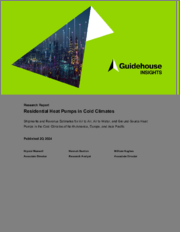
|
시장보고서
상품코드
1501967
세계의 한랭 기후 주택용 히트 펌프Residential Heat Pumps in Cold Climates: Shipments and Revenue Estimates for Air to Air, Air to Water, and Ground-Source Heat Pumps in the Cold Climates of North America, Europe, and Asia Pacific |
||||||
한랭 기후 주택용 히트펌프 시장은 향후 10년간 크게 성장할 것으로 예상됩니다. 주로 인버터 구동 컴프레서나 냉매에서 기술 진보에 의해 히트 펌프는 한랭 기후에서도 충분한 성능을 발휘할 수 있게 되었습니다. 이러한 진보에도 불구하고, 한랭 기후용 히트 펌프 기술의 채택은 일부 유럽 국가와 일본을 제외하면 비교적 낮은 수준에 머물고 있습니다. 그러나 각국 정부와 이해관계자가 보다 광범위한 기후 변화 대책의 일환으로 건축물의 탈탄소화 목표를 추구하는 가운데 난방의 탈탄소화 수단으로서 한랭 기후용 히트펌프의 이용을 요구하는 목소리가 많습니다. 되어 있습니다. 이러한 노력이 향후 10년간의 한랭 기후용 히트 펌프 도입의 주요 촉진요인이 될 것으로 예상됩니다.
현재 시장에 나와 있는 히트 펌프 기술 중 한랭 기후 주택에 적합한 것은 공기 대 공기(Air to Air) 히트 펌프, 공기 대 물(Air to Water) 히트 펌프, 지열 히트 펌프의 3개입니다. 최근 출하량 데이터에 의하면, 북미·유럽·아시아 태평양의 한랭 기후에서는 상기 3유형의 기술의 채택이 확대하고 있습니다. 시장에서는 지금까지 공기 대 공기 히트 펌프가 지배적인 기술이었지만, 특히 유럽에서는 공기 대수 히트 펌프가 보편화됩니다. 한랭 기후 주택난방용 히트펌프 기술의 새로운 용도로 하이브리드형 히트펌프 시스템, 지역난방, 공유지중열 어레이(공유지중열히트펌프라고도 함) 등 성장 가능성을 나타내는 것도 몇 가지 나오고 있습니다.
세계의 한랭 기후 주택용 히트펌프(Residential Heat Pumps in Cold Climates) 시장에 대해 분석했으며, 시장의 기본 동향/촉진·억제요인, 한랭 기후용 히트 펌프 기술의 출하 대수·매출액 동향 전망(2024-2032년), 지역별(북미, 유럽, 아시아 태평양)·기술유형별(공기 대 공기, 공기 대수, 지중 열원 히트 펌프)의 상세 동향 등 정보를 전해드립니다. 또한 지역별 출하 대수·매출액의 성장 동향이나 지역별 성장률의 차이와 그 원인 등도 조사했습니다.
목차
제1장 주요 요약
제2장 시장 문제
- 한랭 기후용 기술 동향
- 가변속 인버터
- 일반적인 한랭 기후용 히트 펌프 기술
- 새로운 활용 영역
- 하이브리드형 히트 펌프 시스템
- 히트 펌프와 지역 난방
- 공용 지열 히트 펌프 시스템
- 시장 성장 촉진요인
- 정부의 정책과 시장변혁의 대처
- 연료비와 연료 부족
- 장벽
- 천연가스 가격 저하
- 전기 서비스 갱신
- 불충분한 건물의 외장이 불충분
- 종업원·고객 교육
- 긴급 교환
제3장 업계의 가치사슬
- 주택용 HVAC의 가치사슬
- 경쟁 구도
- 제조능력 확대
제4장 시장 예측
- 조사 방법
- 시장
- 북미
- 유럽
- 아시아 태평양
제5장 결론 및 제안
- 3개의 큰 포인트
- 권장 사항
- HVAC 제조업체
- 전력 기업
- 천연 가스·유틸리티
- 규제 당국
제6장 약어·두문자어 목록
제7장 목차
제8장 도표
제9장 조사 범위, 정보 출처와 조사 방법, 주석
LYJThe market for residential heat pumps in cold climates is expected to grow considerably over the next decade. Technological advances, primarily in inverter-driven compressors and refrigerants, have enabled heat pumps to perform well in cold climates. Despite these advances, the adoption of heat pump technologies in cold climates has remained relatively low, apart from a few countries in Europe and Japan. However, as governments and stakeholder organizations pursue building decarbonization goals as part of broader climate initiatives, many are calling for the use of heat pumps in cold climates as a way to decarbonize heating. These efforts are likely to be the primary driver for heat pump adoption in cold climates over the next 10 years.
Three predominant heat pump technologies are on the market today and suitable for homes in cold climates: air to air heat pumps, air to water heat pumps, and ground-source heat pumps. Recent historical shipment data shows growing adoption of each of these technologies in cold climates in North America, Europe, and Asia Pacific. While air to air heat pumps have historically been the dominant technology in world markets, air to water heat pumps are becoming more common, particularly in Europe. A few emerging applications of heat pump technology for residential heating in cold climates are also showing growth potential, including hybrid heat pump systems, district heating, and shared geothermal arrays (also known as shared ground-source heat pumps).
This Guidehouse Insights report explores these market trends in detail along with market drivers and barriers specific to cold climates. The forecasts evaluate the estimated shipments and revenue of heat pump technologies in cold climates from 2024 to 2033. They are segmented by region (North America, Europe, and Asia Pacific) and technology type (air to air, air to water, and ground-source heat pumps). The forecasts also provide detailed insights into the unique trends in shipments and revenue growth for each region, including explanations of potential reasons why different technologies appear to be growing faster than others in each region
Table of Contents
1. Executive Summary
2. Market Issues
- 2.1 Technology Trends for Cold Climates
- 2.1.1 Variable Speed Inverters
- 2.2 Common Heat Pump Technologies in Cold Climates
- 2.3 Emerging Applications
- 2.3.1 Hybrid Heat Pump Systems
- 2.3.2 Heat Pumps and District Heating
- 2.3.3 Shared Ground-Source Heat Pump System
- 2.4 Market Drivers
- 2.4.1 Government Policies and Market Transformation Efforts
- 2.4.2 Fuel Costs and Scarcity
- 2.5 Barriers
- 2.5.1 Low Natural Gas Prices
- 2.5.2 Electric Service Upgrades
- 2.5.3 Insufficient Building Envelopes
- 2.5.4 Workforce and Customer Education
- 2.5.5 Emergency Replacements
3. Industry Value Chain
- 3.1 Residential HVAC Value Chain
- 3.2 Competitive Landscape
- 3.3 Growing Manufacturing Capacity
4. Market Forecasts
- 4.1 Methodology
- 4.2 World Markets
- 4.3 North America
- 4.4 Europe
- 4.5 Asia Pacific
5. Conclusions and Recommendations
- 5.1 Three Big Takeaways
- 5.2 Recommendations
- 5.2.1 HVAC Manufacturers
- 5.2.2 Electric Utilities
- 5.2.3 Natural Gas Utilities
- 5.2.4 Regulators













